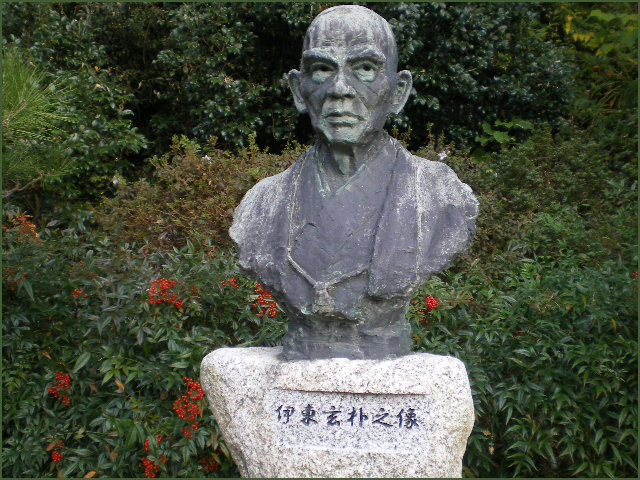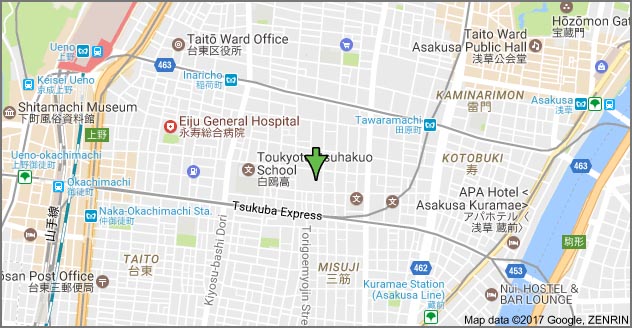[ . BACK to DARUMA MUSEUM TOP . ]
. Famous Places and Powerspots of Edo 江戸の名所 .
::::::::::::::::::::::::::::::
Matsugaechoo 松枝町 / 松ヶ枝町 Matsugae-Cho district
In 大奥 Ōoku, the Women's quarters of the Edo castle lived an Elder Lady named 松ヶ枝 Matsugae.
In 1705, when she retired, this district was given to her to live.

Nearby is the pond Otamagaike お玉ヶ池 and Otama Inari Shrine お玉稲荷.
During the middle ages, this area was along the highway to Oshu, and there was a beautiful woman named Tama who served tea to travelers near the reservoir. 2 men proposed marriage to Tama, however she could not decide between them and drowned herself in the reservoir. It is said the village people dedicated the small shrine to Tama's spirit.
. Kanda Konyachō 神田紺屋町 Konya-Cho district .

source : saurus.coolpage.jp/Walking-
Otama Inari Shrine お玉稲荷
::::::::::::::::::::::::::::::
. Medicine in Edo .
Itoo Genboku 伊藤玄朴 Ito Genboku
(1801 – 1871)

He was born in Saga prefecture in 神埼仁比山 Kanzaki Niiyama.
A doctor and surgeon who had studied with Siebold. He lived in Matsugae district.
He was the first to use a cowpox vaccine.

- quote -
Tomb of Ito Genboku
Ito Genboku was a physician of Dutch medicine at the end of the Edo Period. He was born into an agricultural family from what is now Saga Prefecture in 1800. Wishing to become a doctor, he translated from the Dutch language and studied Western medicine under the German physician Philipp Franz von Siebold in Nagasaki.
He began his practice in Edo (present day Tokyo) in 1828 and, in 1831, became an official physician of the Saga Domain. From 1833, he began to receive many students and visitors at his residence-cum-school known as the Shosen-do located on Shitaya Izumibashi Street.
The central focus of his endeavors came to be the foundation of the first inoculation center in Edo. Built in 1858 in Kanda Otamagaike, it was relocated the following year in Ito's neighborhood on Shitaya Izumibashi Street. In 1860, the Bakufu government took over direct control of the center, renamed it the Seiyo Igaku sho (Institute of Western Medicine), and appointed Genboku in charge of its management. After the transition from Tokugawa rule to the Meiji State in 1868, the institute served as the predecessor of what is now
the University of Tokyo School of Medical Science.

In 1871 Ito Genboku died at the age of 72 and was buried here at Tenryu-in Temple.
- source : taito-culture.jp/city... -
..............................
Philipp Franz Balthasar von Siebold フィリップ・フランツ・バルタザール・フォン・シーボルト
(1796 – 1866)
a German physician, botanist, and traveler. He achieved prominence by his studies of Japanese flora and fauna and the introduction of Western medicine in Japan. He was the father of the first female Japanese doctor, Kusumoto Ine.

- Arrival in Japan
On 28 June 1823, after only a few months in the Dutch East Indies, Siebold was posted as resident physician and scientist to Dejima, a small artificial island and trading post at Nagasaki, and arrived there on 11 August 1823. During an eventful voyage to Japan he only just escaped drowning during a typhoon in the East China Sea. As only a very small number of Dutch personnel were allowed to live on this island, the posts of physician and scientist had to be combined. Dejima had been in the possession of the Dutch East India Company (known as the VOC) since the 17th century, but the Company had gone bankrupt in 1798, after which a trading post was operated there by the Dutch state for political considerations, with notable benefits to the Japanese. ...
... In 1824, Siebold started a medical school in Nagasaki, the Narutaki-juku, that grew into a meeting place for around fifty students. They helped him in his botanical and naturalistic studies. The Dutch language became the lingua franca (common spoken language) for these academic and scholarly contacts for a generation, until the Meiji Restoration.
- Japanese family
During his stay in Japan, Siebold "lived together" with Kusumoto Taki (楠本滝), who gave birth to their daughter Kusumoto (O-)Ine in 1827. Siebold used to call his wife "Otakusa" (probably derived from O-Taki-san) and named a Hydrangea after her. Kusumoto Ine eventually became the first Japanese woman known to have received a physician's training and became a highly regarded practicing physician and court physician to the Empress in 1882. She died at court in 1903.
... Siebold Incident
In 1826 Siebold made the court journey to Edo. During this long trip he collected many plants and animals. But he also obtained from the court astronomer Takahashi Kageyasu several detailed maps of Japan and Korea (written by Inō Tadataka), an act strictly forbidden by the Japanese government. When the Japanese discovered, by accident, that Siebold had a map of the northern parts of Japan, the government accused him of high treason and of being a spy for Russia.
The Japanese placed Siebold under house arrest
and expelled him from Japan on 22 October 1829. Satisfied that his Japanese collaborators would continue his work, he journeyed back on the frigate Java to his former residence, Batavia, in possession of his enormous collection of thousands of animals and plants, his books and his maps. The botanical garden of Buitenzorg would soon house Siebold's surviving, living flora collection of 2,000 plants. ...
- - - More in the WIKIPEDIA !

- quote -
The Legend of Yoshitsune
Could Genghis Khan have actually been a Japanese samurai who went to Mongolia?
The first person who introduced this theory was a well known German Doctor, Philipp Franz Balthasar von Siebold (1796-1866), who was sent to Japan in 1823 by the Dutch government. He carried out research and established a Western style medical school in Edo period Japan while it was still under the rule of samurai.
In his seven volume series "Nippon," he wrote about Yoshitsune and Genghis Khan. During the Meiji period (1868-1912) after the modernization of Japan, some intelligentsia discussed this theory. However it was Oyabe Zenichiro's substantial bestseller of 1924, Genghis Khan wa Minamoto-no-Yoshitsune Nari [Genghis Khan was Yoshitsune] which made this theory known to the public.
- Harada Minoru -
. Genghis Khan (1162 - 1227) .
..............................
. isha 医者, ishi 医師 doctors in Edo .
::::::::::::::::::::::::::::::
. Legends and Tales from Japan 伝説 - Introduction .

oyako tanuki 親子狸 parent and child badger
o-tanuki san おたぬきさん the honorable Tanuki
Once a Tanuki badger family, who lived near the pond Otama-ga-ike お玉ヶ池, close to 東紺屋町 Eastern Konya-Cho.
The original story tells of a wooden sculpture which the 6th Shogun Tokugawa Ienobu 徳川家宣 (1662 - 1712) gave his retainer hatamoto of the 河原林家 Kawarabayashi clan. After the Meiji Restauration, the estate of the clan had to be removed, so the Tanuki statues were given to the shrine.
Praying here brings good luck in all kinds of contests 勝負事.
. Yanagimori jinja 柳森神社 and Tanuki legends .
..............................
- reference : nichibun yokai database -
::::::::::::::::::::::::::::::

- - - To join me on facebook, click the image !
::::::::::::::::::::::::::::::
. Edo bakufu 江戸幕府 The Edo Government .
. Famous Places and Powerspots of Edo 江戸の名所 .
. Kanda 神田 Kanda district .
. Doing Business in Edo - 商売 - Introduction .
. shokunin 職人 craftsman, craftsmen, artisan, Handwerker .
. Japanese Architecture - Interior Design - The Japanese Home .
. Legends and Tales from Japan 伝説 - Introduction .
[ . BACK to DARUMA MUSEUM TOP . ]
[ . BACK to WORLDKIGO . TOP . ]
- - - - - #matsugae #matsugaecho #otamagaike #itogenboku #siebold - - - -
::::::::::::::::::::::::::::::
--
Posted By Gabi Greve to Edo - the EDOPEDIA - on 7/26/2017 12:50:00 pm








































